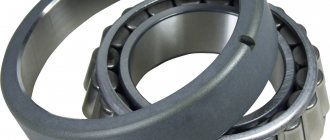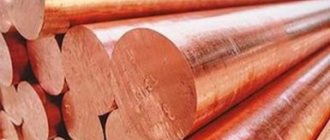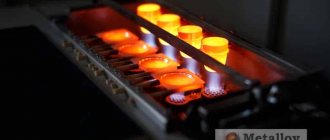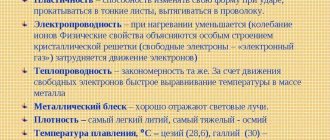The range of commodity items for metal products is very wide. And to produce the products included in each of them, it is necessary that the material have specific properties. Metallurgical plants offer raw materials that meet state standards. But it usually undergoes additional processing at enterprises specializing in the production of steel parts, including hardware. Annealing is one of the main technological operations of this kind. When this is done, the metal acquires the technical characteristics required for successful subsequent processing and ensuring reliable operation of products made from it.
The need for heat treatment of metal
The purpose of this operation is to improve the technological characteristics of raw materials. Its key factor is the annealing temperature of the alloy. The required value of this parameter must be maintained for a certain time interval. As a result, we achieve:
- decrease in hardness index. Thanks to this, it is possible to use a wider range of cutting tools, which helps to reduce production cycle time and significantly reduce labor costs;
- improving the structure of the metal, that is, its microstructure. When this material is exposed to high temperature over a certain period of time, significant transformations occur in it at the molecular level. The alloy structure formed during annealing becomes the most optimal for further physical and mechanical operations;
- Removal (leveling) of internal stress. In the metal that has undergone the pre-treatment stage, the phenomenon of imbalance of the crystalline structure occurs. By correctly selecting the type of annealing of this material, its characteristics necessary for a particular case are achieved.
Sometimes the required technological conditions are achieved by performing incomplete annealing. If you want to give the metal some special quality characteristics, it is practiced to use modes that are characterized by complexity and long duration.
For example, the duration of complete annealing of large and massive products can exceed a day. Most of this time interval is devoted to heating to the required temperature and slow cooling. All this is regulated by GOST, which specifies the requirements for appropriate heat treatment.
In addition, there are periodicals and special literature that describe the annealing procedure in detail. By turning to these sources of information, you can find out that a number of such operations require strict adherence to temperature indicators, when even a few degrees are critical, as well as time regimes.
The procedure can be performed efficiently in a muffle furnace. In the absence of such equipment, carrying out certain types of heat treatment will be associated with difficulties. For orientation, you will have to take into account exclusively the color scheme of the hot metal.
You can anneal steel at home using a simplified scheme. It will not be possible to accurately control the temperature of an object heated with a gas burner. Thus, the adjustment of heating modes followed by cooling is carried out only approximately. When steel is processed in a domestic environment, structural analysis is not possible. Determination of the temperature of the partial annealing process is carried out exclusively visually. The goals of this operation at home are:
- reduction in the strength characteristics of the product;
- increasing the level of machinability of steel products.
Subsequent mechanical processing becomes possible due to the transformation of the metal microstructure after annealing.
Types of annealing
Let's consider what the term “annealing of metals” means. The heat treatment of a metal, consisting of heating above the temperature of the Chernov critical points and cooling, in professional language is called annealing. The procedure is applied to various metals and their alloys.
Industrial enterprises use the following heat treatment modes:
- complete, incomplete;
- recrystallization;
- diffusion;
- isothermal;
- spheroidization;
- normalization.
Complete annealing of steel
Full firing is carried out on products made of hypoeutectoid alloys or steels containing carbon in an amount of ≤ 0.8%. The purpose of the operation is to refine the grain and improve the quality of processing using a cutting tool, relieving internal stresses of the material. Heating occurs 30..50°C above point Ac3, then the part is gradually cooled without removing it from the oven. As it cools, austenite releases fine-grained, homogeneous (uniform structure) ferrites and pearlites (French - pearls). The heating temperature is selected according to the type of steel and the state diagram; the data is recorded in reference materials. The cooling duration is determined according to the composition and structure of the metal:
- carbon alloys - 180...200°C/hour;
- low-alloy - 90°C/hour;
- highly alloyed - 50°C/hour.
After the complete annealing procedure, the heterogeneous structure of carbon or hypoeutectoid alloys becomes homogeneous, which makes it pliable for further processing.
Incomplete
Unlike complete annealing, which radically changes the structural composition of the metal, incomplete annealing changes only the pearlite structure, without affecting the ferrite structure. Perlite, which is part of the structures of steels, cast iron, and other iron-carbon materials, is cementite and ferrite in a eutectoid mixture. The main task of partial annealing is to make the alloys as soft and pliable as possible.
Types of annealing
Metallurgists divide this technological process into 2 types. Let's look at them briefly.
Annealing of the first kind
In this case, phase recrystallization does not occur, but the alloy acquires the desired properties. Annealing of the first kind is intended to reduce the strength of the metal while simultaneously increasing its ductility and toughness. The structure of the material is transformed into a more homogeneous and balanced one. Thanks to partial recrystallization, which reduces the level of internal stress, the products become noticeably more durable and also more reliable.
Annealing of the second kind
Annealing of steel of the second type is characterized by cardinal transformations of the structure. Here phase recrystallization occurs. This phenomenon is ensured:
- heating the alloy to a temperature exceeding critical points;
- precise compliance with the time and temperature parameters of the cooling process.
One point needs to be noted. Critical temperatures represent significant risk factors. For example, overburning causes irreversible structural transformations. Then the metal is classified as an irreparable defect, and it is sent for remelting.
Heat treatment of steels, their annealing, and normalization is a complex process. It allows, using raw materials, to obtain products that meet the requirements of enterprises producing final metal products.
Diffusion annealing
Diffusion annealing is a variant of full annealing. It is carried out for steel ingots. Cast steel is characterized by heterogeneity of chemical composition, as well as dendritic segregation. The operation of diffusion annealing, which is also called homogenization, is carried out at high temperatures, usually up to 1000-1100 °C. Such heating with exposure leads to the elimination or softening of dendritic heterogeneity. However, as a result of such high heating, a coarse-grained structure appears, which requires additional heat treatment, usually annealing. If diffusion annealing was applied to ingots that are intended for metal forming (rolling, forging), then there is no need for annealing - the grain will be refined by subsequent plastic deformation.
Annealing complete, incomplete
The main criterion used to divide annealing into types is the heating temperature of the workpiece. So, if the value of this indicator exceeds the critical points Ac1 and Ac3, heat treatment of this type can be incomplete or complete.
Full annealing
A complete annealing procedure is carried out mainly after casting or any type of hot machining of carbon steel or steel containing alloying additives. In its implementation, the following goals are pursued:
- elimination of existing internal stresses;
- reduction in metal hardness. This will improve its processing using a cutting tool;
- creating a fine-grained structure.
This is ensured by heating the alloy to a temperature (designation T) exceeding the critical point Ac3 (768°С ≤Т≤911°С) by no more than 30°С-50°С, holding until the phase transformations are completely completed, after which it is carried out slow cooling. The requirement to comply with the above temperature rise range at point Ac3 is quite justified. If this characteristic of the heat treatment process leaves its limits upward, the austenite structure will change from fine-grained to coarse-grained. Thus, the set goal will not be achieved, and the metal will not achieve the required quality indicators.
Another important parameter for complete annealing is the cooling rate. It depends on the chemical composition of the alloy. The metal that exhibits a lower degree of stability of supercooled perlite is subject to faster cooling. Therefore they began
- containing alloying additives, cool at a rate of 40°C/hour…60°C/hour;
- carbonaceous ones need to be cooled 2.5 times faster - 100°C/hour...150°C/hour.
After austenite decomposition occurs in the ferritic region, more intensive cooling can be organized. Its implementation is permissible even in open space in atmospheric air.
A different approach is relevant when it is necessary to level out internal stresses in products characterized by a complex configuration. In this case, they need to be cooled in an oven until their temperature is equal to this ambient temperature.
Partial annealing
This heat treatment method involves heating the steel to a level slightly higher than the critical temperature at point Ac1 (approximately 727°C). Incomplete annealing helps to improve the cutting processing of workpieces made from hypereutectoid (containing carbon in an amount of more than 0.8 percent) carbon steels and steels with alloying additives.
The sequence of stages of this technical process looks like this:
- heating the steel to a temperature (designation T) within the range +750°С≤Т≤770°С. This is about 20°С...40°С more than the value of this parameter at the critical point Ac1. There is practically a comprehensive recrystallization of the structure. In this case, lamellar pearlite acquires a spheroidal configuration. In view of this, this operation received another name - spheroidization;
- cooling. It is carried out at a speed no higher than 60°C per hour until the temperature T=600°C is reached. As the amount of alloying additives increases, cooling should proceed more slowly;
- Cooling in an open space exposed to atmospheric air.
Isothermal annealing
When heat treatment of this type, the alloy is heated to the same level as during full annealing. After this, the metal undergoes accelerated cooling until its temperature drops below the Ac1 point and enters the range +660°С≤Т≤680°С. The achieved value of this parameter is maintained for about 6 hours - until the complete collapse of the austenitic structure. Next, the workpieces are cooled due to contact with ambient air.
The advantage of isothermal annealing compared to full annealing is the shorter duration of the procedure. This is especially noticeable when processing alloyed alloys. This method has another advantage: the most homogeneous structure is formed throughout the entire volume of the product. Annealing of workpieces that will be processed by cutting is carried out at a temperature within the range of +930°С≤Т≤950°С. This technological solution provides:
- slight increase in grain size;
- facilitating the processing of products using a cutting tool.
The isothermal annealing procedure is most often used for long rolled metal products made from steels with alloying additives, as well as forgings. For large cages (more than 20 tons) this method is not used. The reason is that transformations in individual fragments of the cage occur at different temperatures.
There is also a specialized isothermal treatment called patenting. It is relevant for a medium-carbon spring alloy with a carbon element content in the range of 0.6%...0.9%. Patenting is used to prepare the wire for the multi-stage reduction procedure during cold drawing. This heat treatment is performed in two stages:
- heating products to approximately 900°C. At this temperature, a comprehensive austenitization of the structure occurs;
- immersion in molten salt with a temperature in the range +450°С≤Т≤600°С.
As a result, thin-lamellar troostite or sorbitol structures are formed. This structure provides:
- high strength properties after final drawing;
- the passage of cold deformations without the occurrence of ruptures;
- possibility of significant compression during broaching.
Diffusion annealing
This annealing has another common name - homogenization. With its use, steel ingots with alloying additives are thermally treated. Diffusion annealing ensures a reduction in the level of intracrystalline heterogeneity or dendritic liquation, due to which the metal develops the following negative properties:
- tendency to fracture, both layered and brittle;
- uneven characteristics in different directions;
- decreased plasticity;
- reduction in viscosity level;
- cracking.
Diffusion annealing is performed as follows: initially the metal is heated to a high temperature (+1200°C). At the same time, its structural parameters are aligned in any direction. The alloy is then aged for fifteen to twenty hours. Cooling is carried out in 2 stages - first accelerated to +800°С≤Т≤820°С, and then slow in atmospheric air.
The result of homogenization is the formation of individual large grains. Subsequently, they are crushed by heat treatment or pressure treatment.
Low temperature annealing
This type of heat treatment has other names - “high tempering” and “low annealing”. This method is quite complex. It involves slowly heating the alloy so that its temperature does not exceed the critical point; holding with maintaining the reached temperature until the metal is completely warmed up; its slow cooling in the oven.
Purpose
Heat treatment in the form of low-temperature annealing is intended to improve the degree of workability of alloyed chromium (contain impurities of the Cr element) and chromium-nickel (in addition to the Cr element, the composition includes the Ni element) by:
- decrease in hardness index;
- leveling existing internal stresses.
Another purpose of low annealing is to obtain granular pearlite. The presence of cementite and ferrite in the structure of this hypoeutectoid mixture provides the steel with improved elongation properties and increases the strength threshold.
Process characteristics
The need to maintain technological accuracy is the main feature of low annealing. If the heat treatment conditions are violated, the occurrence of repeated internal stresses cannot be ruled out.
The initial stage of this technical process is the slow heating of products to a temperature taking values from the range +600°С≤Т≤680°С, that is, below the Ac1 point. To determine exact temperature indicators, you need to use special formulas that take into account the temperatures at which melting and recrystallization of the metal occurs.
Structural changes are also a characteristic derived from:
- chemical composition of the material;
- original structure;
- holding time.
It should be noted that as the heating temperature increases, a shorter time interval is allocated for holding. Its limit values are as follows: minimum 2 and maximum 8 hours. And one more point: metal processing by low-temperature annealing is characterized by the absence of phase recrystallization. The formation of a sorbitol structure occurs, accompanied by an increase in the level of impact strength, but a decrease in hardness.
Recrystallization annealing
During the processing of steel blanks by pressure, strain hardening of the alloy is carried out, which is usually called cold hardening or cold hardening. To increase the level of ductility and simultaneously reduce rigidity, a method called recrystallization annealing is used.
This method of heat treatment involves heating the metal to a point exceeding the crystallization temperature by no less than one hundred to two hundred degrees (for carbon steel it is somewhere around 700 ºC) and holding it for a certain period of time. The final stage of this procedure is cooling the alloy.
When cold stamping is carried out, recrystallization annealing can act as:
- a preliminary or interoperational stage performed to reduce the rigidity of the workpiece;
- the final stage of the entire technical process, the purpose of which is to impart the desired plasticity to the finished product.
Low temperature annealing
| Heterodiffusion of P32 at 700 C, stimulated by ion bombardment of P31. doses of P31 ions ( cm-2 – 5 – 10th, 5 – 10 5. |
Low-temperature annealing (70 – 100 C) leads to an increase in the concentration of A centers, since oxygen atoms contained in silicon (concentrations 1016 – 1017 cm-3) diffuse to the vacancies created during irradiation and bind to them. When the samples are heated to 170 C, the process of formation of L centers stops, and above 170 C the centers begin to disappear. Annealing at 310 – 350 C already leads to the disintegration of L - centers.
Low-temperature annealing for copper stamped products is carried out at 400 - 450 C, and for brass - at 500 - 540 C. High annealing is carried out for copper at 600 - 650 C, for brass - at 650 - 700 C.
| Isothermal annealing modes of various grades of tool steels. |
Low-temperature annealing is used to reduce the hardness of alloy steels and eliminate internal stresses in workpieces that have undergone cold stamping or mechanical cutting. The workpieces are slowly heated to a temperature of 650 - 700 C, kept at this temperature until completely warmed up, then cooled together with the furnace or in a box with dry sand. This process is sometimes called high tempering.
Low-temperature annealing (high tempering) is characterized by heating to a temperature below L, holding and slow cooling. It is used to relieve internal stresses that arise, in particular, during welding, in cold-worked metal, as well as for metal recrystallization. In industrial practice, this type of heat treatment is sometimes called low annealing.
Low-temperature annealing - heating steel to a temperature below the transformation range; holding at this temperature and subsequent cooling, usually in air. Low-temperature annealing is used mainly to relieve internal stresses after rough machining of alloy steel forgings.
Low-temperature annealing is used to reduce internal stresses in castings. It is carried out by slowly heating the castings to a temperature of 500 - 600 C with holding for 10 - 12 hours and subsequent slow cooling along with the furnace.
Low-temperature annealing (high tempering) is used mainly for alloy steels (chromium, chromium-nickel, etc.), to relieve internal stress, to reduce hardness and to avoid the formation of flakes. There is no phase recrystallization during this type of annealing. Complete removal of internal stresses is achieved by heating to 600, therefore low-temperature annealing can be carried out in a wide temperature range from 600 to the point Ar. The higher the heating temperature, the shorter the shutter speed for relieving internal stresses. Cooling after heating must be slow enough so that internal stress does not arise again.
Low-temperature annealing is used to relieve internal residual stresses in gray cast iron castings. This annealing is carried out according to the following regime: slow heating of the castings (30 - 180 C / h) to 530 - 620 C, holding at this temperature for 3 - 4 hours (from the moment of heating the thickest section of the casting to a given temperature) and slow cooling with the furnace at a speed of 10 - 30 C / h to 300 - 400 C. Annealing at higher temperatures can cause graphitization of eutectoid cementite, reducing the hardness and strength of cast iron.
Low-temperature annealing is intended to relieve casting stresses in castings. Castings from gray and bleach. The duration of exposure during low-temperature annealing is 1 hour per 25 mm section of the casting, followed by cooling in the furnace to 400 - 300, then in air.
Low-temperature annealing is intended to relieve casting stresses in castings. Castings from gray and bleach. The duration of exposure during low-temperature annealing is 1 hour per 25 mm section of the casting, followed by cooling in the furnace to 400 - 300, then in air.
| Schemes of heating devices. |
Low-temperature annealing (high tempering) is used after hardening to soften the structure and remove or reduce residual stresses. During low-temperature annealing, the metal is heated to a temperature below the critical point / 4C, (600 - 680 C), maintained at this temperature and slowly cooled.
Low-temperature annealing after welding is the means that most completely eliminates residual stresses.
Features of annealing various alloys
When assigning a method and mode of heat treatment, the percentage of carbon and other impurities in it is important. To accurately adhere to the regime, it is recommended to use two furnaces: in the 1st, the product is heated at t=max, in the 2nd, it undergoes a holding period, ensuring the completion of the structural transformations of the metal. Stainless steel is processed in the first furnace at t=1000°С, then held for several hours in the second furnace at t=900, completes cooling to t=300° at a speed of 50...100 degrees/hour, final cooling is carried out in an open space.









